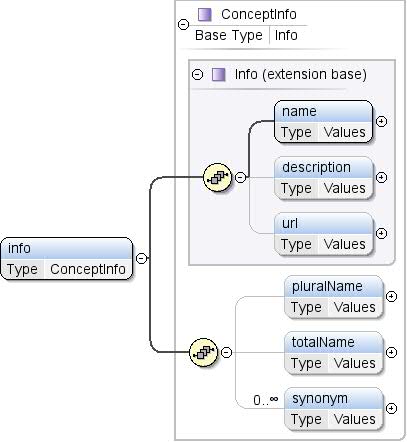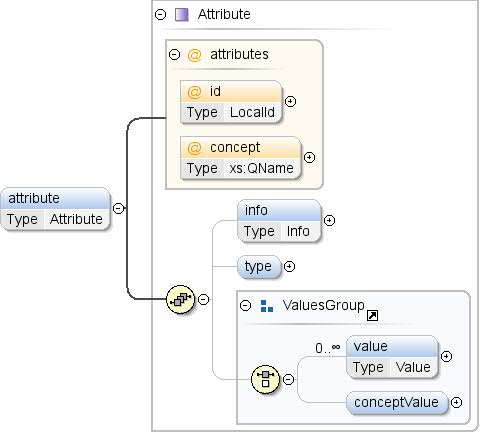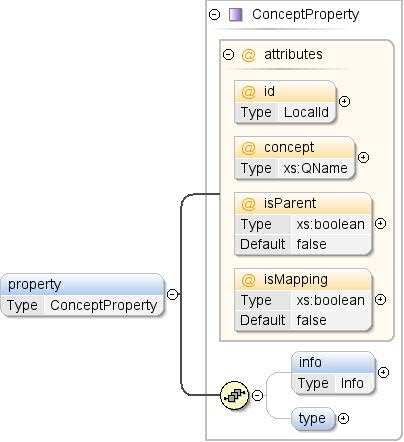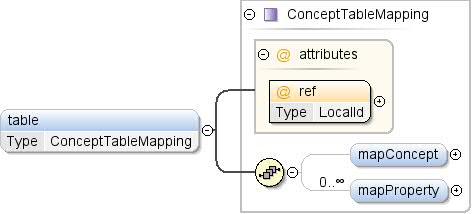Komponente: Konzept
Mit Sammlungen den Überblick behalten
Sie können Inhalte basierend auf Ihren Einstellungen speichern und kategorisieren.
Element: Konzept / info
| Namespace |
http://schemas.google.com/dspl/2010 |
| Annotationen |
Textinformationen wie Name und Beschreibung des
Konzept. |
| Diagramm |
 |
| Typ |
ConceptInfo |
| Typhierarchie |
|
| Attribute |
|
| Modell |
name , description{0,1} , url{0,1} , pluralName{0,1} , totalName{0,1} , Synonym* |
| Children |
description, name, pluralName,
Synonym, totalName, url |
| Instanz |
<info>
<name>{1,1}</name>
<description>{0,1}</description>
<url>{0,1}</url>
</info>
|
| Quelle |
<xs:element name="info" type="ConceptInfo">
<xs:annotation>
<xs:documentation>Textual information, such as the name and description of
the concept.</xs:documentation>
</xs:annotation>
</xs:element>
|
Element: Konzept / Thema
| Namespace |
http://schemas.google.com/dspl/2010 |
| Annotationen |
Ein Thema, mit dem das Konzept verknüpft ist. |
| Diagramm |
 |
| Attribute |
| content: |
komplex |
| minOccurs (Mindestanzahl): |
0 |
| maxOccurs: |
unbegrenzt |
|
| Attribute |
| QName |
Typ |
Behoben |
Standard |
Verwenden |
Annotation |
| Ref. |
xs:QName |
|
|
optional |
Die eindeutige Kennzeichnung des Themas, das für dieses Konzept verwendet wird
verknüpft sind. Das referenzierte Thema kann im selben
oder extern, d.h. in einem anderen Dataset. Ein Verweis auf eine
„Externes Thema“ muss das Format haben
„prefix:other_topic_id“, wobei „präfix“ ist der
Präfix, das für den Namespace des externen Datasets verwendet wird (siehe XML)
Namespaces). |
|
| Quelle |
<xs:element name="topic" minOccurs="0" maxOccurs="unbounded">
<xs:annotation>
<xs:documentation>A topic the concept is associated with.</xs:documentation>
</xs:annotation>
<xs:complexType>
<xs:attribute name="ref" type="xs:QName">
<xs:annotation>
<xs:documentation>The unique identifier of the topic this concept is
associated with.
The referenced topic may be defined in the same
dataset or externally, i.e., in another dataset. A
reference to an external topic must be of the form
"prefix:other_topic_id", where "prefix" is the prefix
used for the namespace of the external dataset (see
XML namespaces).</xs:documentation>
</xs:annotation>
</xs:attribute>
</xs:complexType>
</xs:element>
|
Element: Konzept / Typ
| Namespace |
http://schemas.google.com/dspl/2010 |
| Annotationen |
Der Datentyp des Konzepts. Ein Konzept muss einen Typ bereitstellen,
oder ein anderes Konzept erweitern. Für den Fall, dass
zur Erweiterung eines Konzepts, kann auch eine Typdeklaration bereitgestellt werden. Die Art der
muss das erweiterte Konzept weniger restriktiv sein als der Typ des
Konzept erweitern. „Weniger restriktiv als“ (LRT) ist ein
Teilreihenfolge wie folgt definiert: string LRT float float float LRT integer
string LRT date string LRT boolean |
| Diagramm |
 |
| Attribute |
| content: |
komplex |
| minOccurs (Mindestanzahl): |
0 |
|
| Attribute |
| QName |
Typ |
Behoben |
Standard |
Verwenden |
Annotation |
| Ref. |
DataType |
|
|
erforderlich |
|
|
| Quelle |
<xs:element name="type" minOccurs="0">
<xs:annotation>
<xs:documentation>The data type of the concept. A concept must provide a type declaration or extend
another concept. In the case where it's extending a concept, it may also
provide a type declaration. The type of the extended concept must be less restrictive
than the type of the concept extending it.
"Less restrictive than" (LRT) is a partial order defined as follows:
string LRT float
float LRT integer
string LRT date
string LRT boolean</xs:documentation>
</xs:annotation>
<xs:complexType>
<xs:attribute name="ref" type="DataType" use="required"/>
</xs:complexType>
</xs:element>
|
Element: Konzept / Attribut
| Namespace |
http://schemas.google.com/dspl/2010 |
| Annotationen |
Ein Attribut des Konzepts. Attribute stehen für zusätzliche
Informationen zum Konzept (z.B. Das BIP ist ein Prozentsatz). |
| Diagramm |
 |
| Typ |
Attribut |
| Attribute |
| content: |
komplex |
| minOccurs (Mindestanzahl): |
0 |
| maxOccurs: |
unbegrenzt |
|
| Modell |
info{0,1} , type{0,1} , (Wert*
| conceptValue{0,1}) |
| Children |
conceptValue, info, Typ,
Wert |
| Instanz |
<attribute concept="" id="">
<info>{0,1}</info>
<type format="" ref="">{0,1}</type>
</attribute>
|
| Attribute |
| QName |
Typ |
Behoben |
Standard |
Verwenden |
Annotation |
| Konzept |
xs:QName |
|
|
optional |
Ein Verweis auf ein Konzept, das den Werten entspricht
des Attributs. Wenn das Attribut einen Typ angibt,
muss mit dem Typ des referenzierten Konzepts übereinstimmen. Ein Verweis auf eine
muss das Format eines externen Konzepts
„präfix:other_concept_id“, wobei „präfix“ ist
Das für den Namespace des externen Datasets verwendete Präfix (siehe XML)
Namespaces). |
| id |
LocalId |
|
|
optional |
Die ID des Konzeptattributs. Diese Kennung muss
innerhalb des Konzepts (über Attribute und Eigenschaften hinweg) eindeutig sein sollte. Die
id [ID] kann weggelassen werden, wenn das Konzeptattribut angegeben ist. Dabei
wird implizit eine ID mit dem lokalen Namen des
Konzept verwendet. Beispiel: <attribute
concept="unit:currency"/> entspricht
<attribute id="currency"
concept="unit:currency"/> |
|
| Quelle |
<xs:element name="attribute" type="Attribute" minOccurs="0" maxOccurs="unbounded">
<xs:annotation>
<xs:documentation>An attribute of the concept. Attributes represent additional
information about the concept (e.g., GDP is a percentage).</xs:documentation>
</xs:annotation>
</xs:element>
|
Element: Konzept / Property
| Namespace |
http://schemas.google.com/dspl/2010 |
| Annotationen |
Eine Eigenschaft des Konzepts. Eigenschaften stehen für zusätzliche
Informationen zu Instanzen des Konzepts (z.B. ein Konzept)
"Stadt" die Property „country“ haben. |
| Diagramm |
 |
| Typ |
ConceptProperty |
| Attribute |
| content: |
komplex |
| minOccurs (Mindestanzahl): |
0 |
| maxOccurs: |
unbegrenzt |
|
| Modell |
info{0,1} , Typ{0,1} |
| Children |
Info, Typ |
| Instanz |
<property concept="" id="" isMapping="false" isParent="false">
<info>{0,1}</info>
<type ref="">{0,1}</type>
</property>
|
| Attribute |
| QName |
Typ |
Behoben |
Standard |
Verwenden |
Annotation |
| Konzept |
xs:QName |
|
|
optional |
Ein Verweis auf ein Konzept, das den Werten entspricht
der Unterkunft. Wenn die Eigenschaft einen Typ angibt,
muss mit dem Typ des referenzierten Konzepts übereinstimmen. Ein Verweis auf eine
muss das Format eines externen Konzepts
„prefix:other_concept_id“, wobei „präfix“ ist
Das für den Namespace des externen Datasets verwendete Präfix (siehe XML)
Namespaces). |
| id |
LocalId |
|
|
optional |
Die ID der Konzepteigenschaft. Diese Kennung muss
innerhalb des Konzepts (über Attribute und Eigenschaften hinweg) eindeutig sein sollte. Die
id [ID] kann weggelassen werden, wenn die Konzepteigenschaft angegeben ist. Dabei
wird implizit eine ID mit dem lokalen Namen des
Konzept verwendet. Beispiel: <property
concept="geo:country"/> entspricht <property
id="country"
concept="geo:country"/> |
| isMapping |
xs:boolean |
|
falsch |
optional |
Bei „true“ muss diese Eigenschaft auf ein Konzept verweisen.
Diese Eigenschaft bezeichnet eine Zuordnungsbeziehung (1-zu-1) zwischen diesem
und das referenzierte Konzept verwendet. Jede Instanz des referenzierten
Konzept wird von höchstens einer Instanz dieses
Konzept. |
| isParent |
xs:boolean |
|
falsch |
optional |
Bei „true“ muss diese Eigenschaft auf ein Konzept verweisen.
Diese Eigenschaft zeigt eine hierarchische Beziehung zwischen diesem
und das referenzierte Konzept (z.B. der Kontinent eines
Land). |
|
| Quelle |
<xs:element name="property" type="ConceptProperty" minOccurs="0" maxOccurs="unbounded">
<xs:annotation>
<xs:documentation>A property of the concept. Properties represent additional
information about instances of the concept (e.g., a concept
"city" may have a property "country").</xs:documentation>
</xs:annotation>
</xs:element>
|
Element: Konzept / defaultValue
| Namespace |
http://schemas.google.com/dspl/2010 |
| Annotationen |
Standardwert für das Konzept, der von Anwendungen verwendet wird
wenn sie einen der möglichen Werte
Konzept. |
| Diagramm |
 |
| Typ |
Werte |
| Attribute |
| content: |
komplex |
| minOccurs (Mindestanzahl): |
0 |
|
| Modell |
Wert* | conceptValue{0,1} |
| Children |
conceptValue, Wert |
| Instanz |
<defaultValue>
<value lang="">{0,unbounded}</value>
<conceptValue concept="">{0,1}</conceptValue>
</defaultValue>
|
| Quelle |
<xs:element name="defaultValue" type="Values" minOccurs="0">
<xs:annotation>
<xs:documentation>A default value for the concept, to be used by
applications when they need to pick one of the possible
values of the concept.</xs:documentation>
</xs:annotation>
</xs:element>
|
Element: Konzept / Tabelle
| Namespace |
http://schemas.google.com/dspl/2010 |
| Annotationen |
Ein Verweis auf eine Tabelle, die alle möglichen Werte enthält
für das Konzept und seine nicht konstanten Eigenschaften. |
| Diagramm |
 |
| Typ |
ConceptTableMapping |
| Attribute |
| content: |
komplex |
| minOccurs (Mindestanzahl): |
0 |
|
| Modell |
mapConcept{0,1} , mapProperty* |
| Children |
mapConcept, mapProperty |
| Instanz |
<table ref="">
<mapConcept toColumn="">{0,1}</mapConcept>
<mapProperty lang="" ref="" toColumn="">{0,unbounded}</mapProperty>
</table>
|
| Attribute |
| QName |
Typ |
Behoben |
Standard |
Verwenden |
Annotation |
| Ref. |
LocalId |
|
|
erforderlich |
Die ID der Tabelle, die die Daten für die
Konzept. |
|
| Quelle |
<xs:element name="table" type="ConceptTableMapping" minOccurs="0">
<xs:annotation>
<xs:documentation>A reference to a table that contains all the
possible values for the concept and its non-constant
properties.</xs:documentation>
</xs:annotation>
</xs:element>
|
Komplexer Typ: Konzept
| Namespace |
http://schemas.google.com/dspl/2010 |
| Annotationen |
Ein Konzept ist eine Definition eines Datentyps, der in der
(z.B. „BIP“ oder "Landkreis"). Ein Konzept kann
die mit einer Aufzählung aller möglichen Werte verknüpft sind. A
auf das in einem Dataset definierte Konzept auch in anderen
Datasets. |
| Diagramm |
 |
| Verwendet von |
|
| Modell |
info , topic* , type{0,1} ,
Attribut* , Property* , defaultValue{0,1} , Tabelle{0,1} |
| Children |
Attribut, defaultValue, info,
Property, Tabelle, Thema
Typ |
| Attribute |
| QName |
Typ |
Behoben |
Standard |
Verwenden |
Annotation |
| erweitert |
xs:QName |
|
|
optional |
Die eindeutige Kennung eines Konzepts, das von diesem Konzept
erweitert. Das referenzierte Konzept kann im selben Dataset definiert werden
oder extern, d.h. in einem anderen Dataset. Ein Verweis auf eine externe
Konzept muss das Format "prefix:other_concept_id" haben,
wobei „Präfix“ ist das Präfix, das für den Namespace von
Das externe Dataset (siehe XML-Namespaces) |
| id |
ID |
|
|
erforderlich |
Die eindeutige Kennung des Konzepts. Diese muss
global nur einmal im Dataset. |
|
| Quelle |
<xs:complexType name="Concept">
<xs:annotation>
<xs:documentation>A concept is a definition of a type of data that appears in the
dataset (e.g., "GDP" or "County"). A concept may be associated with
an enumeration of all its possible values or not. A concept defined in
some dataset may be referenced in other datasets.</xs:documentation>
</xs:annotation>
<xs:sequence>
<xs:element name="info" type="ConceptInfo">
<xs:annotation>
<xs:documentation>Textual information, such as the name and description of
the concept.</xs:documentation>
</xs:annotation>
</xs:element>
<xs:element name="topic" minOccurs="0" maxOccurs="unbounded">
<xs:annotation>
<xs:documentation>A topic the concept is associated with.</xs:documentation>
</xs:annotation>
<xs:complexType>
<xs:attribute name="ref" type="xs:QName">
<xs:annotation>
<xs:documentation>The unique identifier of the topic this concept is
associated with.
The referenced topic may be defined in the same
dataset or externally, i.e., in another dataset. A
reference to an external topic must be of the form
"prefix:other_topic_id", where "prefix" is the prefix
used for the namespace of the external dataset (see
XML namespaces).</xs:documentation>
</xs:annotation>
</xs:attribute>
</xs:complexType>
</xs:element>
<xs:element name="type" minOccurs="0">
<xs:annotation>
<xs:documentation>The data type of the concept. A concept must provide a type declaration or extend
another concept. In the case where it's extending a concept, it may also
provide a type declaration. The type of the extended concept must be less restrictive
than the type of the concept extending it.
"Less restrictive than" (LRT) is a partial order defined as follows:
string LRT float
float LRT integer
string LRT date
string LRT boolean</xs:documentation>
</xs:annotation>
<xs:complexType>
<xs:attribute name="ref" type="DataType" use="required"/>
</xs:complexType>
</xs:element>
<xs:element name="attribute" type="Attribute" minOccurs="0" maxOccurs="unbounded">
<xs:annotation>
<xs:documentation>An attribute of the concept. Attributes represent additional
information about the concept (e.g., GDP is a percentage).</xs:documentation>
</xs:annotation>
</xs:element>
<xs:element name="property" type="ConceptProperty" minOccurs="0" maxOccurs="unbounded">
<xs:annotation>
<xs:documentation>A property of the concept. Properties represent additional
information about instances of the concept (e.g., a concept
"city" may have a property "country").</xs:documentation>
</xs:annotation>
</xs:element>
<xs:element name="defaultValue" type="Values" minOccurs="0">
<xs:annotation>
<xs:documentation>A default value for the concept, to be used by
applications when they need to pick one of the possible
values of the concept.</xs:documentation>
</xs:annotation>
</xs:element>
<xs:element name="table" type="ConceptTableMapping" minOccurs="0">
<xs:annotation>
<xs:documentation>A reference to a table that contains all the
possible values for the concept and its non-constant
properties.</xs:documentation>
</xs:annotation>
</xs:element>
</xs:sequence>
<xs:attribute name="id" type="Id" use="required">
<xs:annotation>
<xs:documentation>The unique identifier of the concept, which must be globally
unique within the dataset.</xs:documentation>
</xs:annotation>
</xs:attribute>
<xs:attribute name="extends" type="xs:QName" use="optional">
<xs:annotation>
<xs:documentation>The unique identifier of a concept that this
concept extends.
The referenced concept may be defined in the same
dataset or externally, i.e., in another dataset. A
reference to an external concept must be of the form
"prefix:other_concept_id", where "prefix" is the
prefix used for the namespace of the external
dataset (see XML namespaces).</xs:documentation>
</xs:annotation>
</xs:attribute>
</xs:complexType>
|
| Namespace |
Kein Namespace |
| Annotationen |
Die eindeutige Kennzeichnung des Themas, mit dem dieses Konzept verknüpft ist
mit. Das referenzierte Thema kann im selben Dataset oder
d.h. in einem anderen Dataset. Ein Verweis auf ein externes Thema
muss das Format „prefix:other_topic_id“ haben, wobei
„Präfix“ ist das Präfix, das für den Namespace des externen
(siehe XML-Namespaces). |
| Typ |
xs:QName |
| Attribute |
|
| Verwendet von |
|
| Quelle |
<xs:attribute name="ref" type="xs:QName">
<xs:annotation>
<xs:documentation>The unique identifier of the topic this concept is
associated with.
The referenced topic may be defined in the same
dataset or externally, i.e., in another dataset. A
reference to an external topic must be of the form
"prefix:other_topic_id", where "prefix" is the prefix
used for the namespace of the external dataset (see
XML namespaces).</xs:documentation>
</xs:annotation>
</xs:attribute>
|
| Namespace |
Kein Namespace |
| Typ |
DataType |
| Attribute |
| verwenden Sie zum Beispiel: |
erforderlich |
|
| Attribute |
| Aufzählung |
String |
|
| Aufzählung |
float |
|
| Aufzählung |
Ganzzahl |
|
| Aufzählung |
boolean |
|
| Aufzählung |
Datum |
|
| Aufzählung |
Konzept |
|
|
| Verwendet von |
|
| Quelle |
<xs:attribute name="ref" type="DataType" use="required"/>
|
Attribut: Concept / @id
| Namespace |
Kein Namespace |
| Annotationen |
Die eindeutige Kennung des Konzepts, die global sein muss
innerhalb des Datasets nur einmal vorkommen. |
| Typ |
ID |
| Attribute |
| verwenden Sie zum Beispiel: |
erforderlich |
|
| Attribute |
|
| Verwendet von |
|
| Quelle |
<xs:attribute name="id" type="Id" use="required">
<xs:annotation>
<xs:documentation>The unique identifier of the concept, which must be globally
unique within the dataset.</xs:documentation>
</xs:annotation>
</xs:attribute>
|
Attribut: Concept / @extends
| Namespace |
Kein Namespace |
| Annotationen |
Die eindeutige Kennung eines Konzepts, das durch dieses Konzept erweitert wird.
Das referenzierte Konzept kann im selben Dataset oder extern definiert werden.
d.h. in einem anderen Dataset. Ein Verweis auf ein externes Konzept muss
das Format "prefix:other_concept_id", wobei "prefix" ist
Das für den Namespace des externen Datasets verwendete Präfix (siehe XML)
Namespaces). |
| Typ |
xs:QName |
| Attribute |
| verwenden Sie zum Beispiel: |
optional |
|
| Verwendet von |
|
| Quelle |
<xs:attribute name="extends" type="xs:QName" use="optional">
<xs:annotation>
<xs:documentation>The unique identifier of a concept that this
concept extends.
The referenced concept may be defined in the same
dataset or externally, i.e., in another dataset. A
reference to an external concept must be of the form
"prefix:other_concept_id", where "prefix" is the
prefix used for the namespace of the external
dataset (see XML namespaces).</xs:documentation>
</xs:annotation>
</xs:attribute>
|
Erstellt mit dem
oXygen XML Editor
Sofern nicht anders angegeben, sind die Inhalte dieser Seite unter der Creative Commons Attribution 4.0 License und Codebeispiele unter der Apache 2.0 License lizenziert. Weitere Informationen finden Sie in den Websiterichtlinien von Google Developers. Java ist eine eingetragene Marke von Oracle und/oder seinen Partnern.
Zuletzt aktualisiert: 2025-07-25 (UTC).
[[["Leicht verständlich","easyToUnderstand","thumb-up"],["Mein Problem wurde gelöst","solvedMyProblem","thumb-up"],["Sonstiges","otherUp","thumb-up"]],[["Benötigte Informationen nicht gefunden","missingTheInformationINeed","thumb-down"],["Zu umständlich/zu viele Schritte","tooComplicatedTooManySteps","thumb-down"],["Nicht mehr aktuell","outOfDate","thumb-down"],["Problem mit der Übersetzung","translationIssue","thumb-down"],["Problem mit Beispielen/Code","samplesCodeIssue","thumb-down"],["Sonstiges","otherDown","thumb-down"]],["Zuletzt aktualisiert: 2025-07-25 (UTC)."],[],["Concepts, within a dataset (namespace: `http://schemas.google.com/dspl/2010`), define data types and are globally unique. Concepts can extend others, using `prefix:other_concept_id` for external references. They include `info` (textual details), `topic` (associated topics via `ref`), `type` (data type, `ref`), `attribute` (additional information), `property` (instance information), `defaultValue`, and `table` (data source, `ref`). Key concept attributes are `id` (unique), and `extends` (referencing another concept). External references are in `prefix:identifier` format. A concept must have a `type` or `extends`.\n"]]







